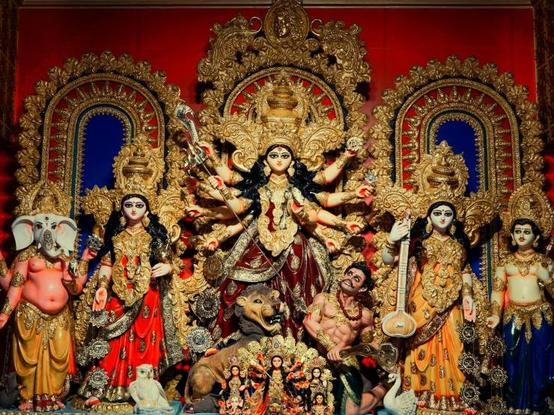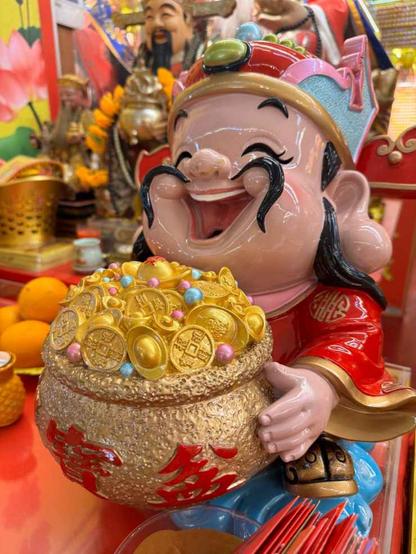Tridevi
This is a trinity of supreme divinity in Hinduism. This joins a triad of well-known goddesses of the Trimurti, or as consorts of a masculine Trimurti. This depends on the denomination of Hinduism. This triad is typically personified by the Hindu goddesses Saraswati, Lakshmi, & Parvati. In Shaktism, these triune goddesses are the manifestations of Mula-Prakriti or Mahadevi. Triune means “3 in 1″ or 3 united in 1.”
In traditional masculine/male-centered (androcentric) denominations of Hinduism, the female Tridevi goddesses are relegated as consorts & auxiliary deities to the male/masculine Trimurti gods.
In Shaktism, the female/feminine Tridevi goddesses are given prominent roles of creator (Mahasaraswati), preserver (Mahalakshmi), & destroyer (Mahakali). In this sect, the male/masculine Trimurti God’s being put into auxiliary deities as agents of the female/feminine Tridevi.
Saraswati is the goddess of learning, acts, & music. She’s also the consort of Brahma, the creator.
Lakshmi is the goddess of fortune, wealth, fertility, auspiciousness, light, material & spiritual fulfillment. She’s the consort of Vishnu, the maintainer or preserver. Lakshmi doesn’t signify mere material wealth, but also abstract prosperity, such as glory, magnificence, joy, exaltation, greatness, & spiritual fulfillment. This translates to moksha. Moksha is liberation or release from the cycle of life, death, rebirth.
Parvati is the goddess of power, war, beauty, & love. She’s the consort of Shiva, the destroyer of evil, or transformer.
Mahasarasvati is described to be the slayer of Shumba in Devi Bhagavata Purana. This suggests that she has little to do with Saraswati.
Mahalakshmi is the prosperity aspect of Devi. She has 2 forms, Vishnu-priya Lakshmi & Rajyalakshmi. The former is the embodiment of chastity & virtuousness. The latter goes about courting kings.
Rajyalakshmi is stated to be fickle & impulsive. She enters all those places where virtue & charity may be found. As soon as these 2 vanish from any place, Rajyalakshmi will also vanish from that place.
Mahakali represents darkness, pure tamas personified. Mahakali is 1 of the 3 primary forms of Devi. She’s stated to be a powerful cosmic aspect (vyasti) of Devi & represents the guna (universal energy) named tamas, & is the personification of the universal power of transformation, the transcendent power of time.
Via Buddhism & syncretism with Japanese Shinto deities, the Tridevi entered Japanese mythology as the goddesses Benzaitennyo (Sarasvati), Kisshoutennyo (Lexmi), & Daikokutennyo (Mahakali or Parvati).
One-Time Monthly YearlyMake a one-time donation
Make a monthly donation
Make a yearly donation
Choose an amount
$1.00 $5.00 $10.00 $1.00 $5.00 $10.00 $5.00 $10.00 $15.00Or enter a custom amount
$Your contribution is appreciated.
Your contribution is appreciated.
Your contribution is appreciated.
DonateDonate monthlyDonate yearly
#Androcentric #Benzaitennyo #Brahma #Buddhism #Consorts #Daikokutennyo #Devi #DeviBhagavataPurana #Guna #Hindu #HinduMythology #HinduTridevi #Hinduism #HinduismPantheon #Japanese #JapaneseMythology #Kisshoutennyo #Lakshmi #Mahadevi #Mahakali #Mahalakshmi #Mahasarawati #MulaPrakriti #Parvati #Rajyalakshmi #Saraswati #Shaktism #Shinto #Shiva #Tamas #Tridevi #Trimurti #Trinity #Triune #Vishnu #VishnuPriyaLakshmi #Vyasti

